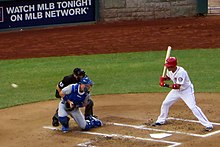
Back Wild Pitch German Mauvais lancer French Lancio pazzo Italian 暴投 Japanese 폭투 Korean Wild pitch Polish Wild pitch Swedish 暴投 Chinese

In baseball, a wild pitch (WP) is charged against a pitcher when his pitch is too high, too short, or too wide of home plate for the catcher to control with ordinary effort, thereby allowing a baserunner, or the batter (on an uncaught third strike), to advance.[1]
A wild pitch usually passes the catcher behind home plate, often allowing runners on base an easy chance to advance while the catcher chases the ball down. Sometimes the catcher may block a pitch, and the ball may be nearby, but the catcher has trouble finding the ball, allowing runners to advance.
A closely related statistic is the passed ball. As with many baseball statistics, whether a pitch that gets away from a catcher is counted as a wild pitch or a passed ball is at the discretion of the official scorer. The benefit of the doubt is usually given to the catcher if there is uncertainty; therefore, most of these situations are scored as wild pitches. If the pitch was so low as to touch the ground, or so high that the catcher has to jump to get to it, or so wide that the catcher has to lunge for it, it is usually ruled a wild pitch and not a passed ball.[1] Because the pitcher and catcher handle the ball much more than other fielders, certain misplays on pitched balls are defined in Rule 10.13 as wild pitches and passed balls. No error shall be charged when a wild pitch or passed ball is scored.
A wild pitch may only be scored if one or more runners advance. If the bases are empty, or if the catcher retrieves the ball quickly and no runner is able to advance, a wild pitch is not charged. A run scored on a wild pitch is recorded as an earned run. A runner who advances on a wild pitch is not credited with a stolen base unless he breaks before the pitcher begins his delivery.
- ^ a b "Wild Pitch (WP)". MLB.com. Archived from the original on 23 June 2021. Retrieved 29 June 2021.
© MMXXIII Rich X Search. We shall prevail. All rights reserved. Rich X Search